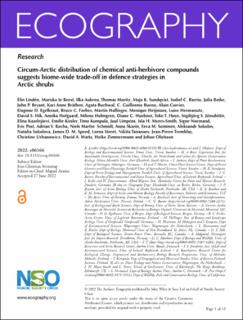Circum-Arctic distribution of chemical anti-herbivore compounds suggests biome-wide trade-off in defence strategies in Arctic shrubs
Lindén, Elin; te Beest, Mariska; Aubreu, Ilka; Moritz, Thomas; Sundqvist, Maja K.; Barrio, Isabel C.; Boike, Julia; Bryant, John P.; Bråthen, Kari Anne; Buchwal, Agata; Bueno, C. Guillermo; Currier, Alain; Egelkraut, Dagmar Dorothea; Forbes, Bruce C.; Hallinger, Martin; Heijmans, Monique; Hermanutz, Luise; Hik, David S.; Hofgaard, Annika; Holmgren, Milena; Huebner, Diane C.; Høye, Toke T.; Jónsdóttir, Ingibjörg S.; Kaarlejärvi, Elina; Kissler, Emilie; Kumpula, Timo; Limpens, Juul; Myers-Smith, Isla H.; Normand, Signe; Post, Eric; Rocha, Adrian V.; Schmidt, Niels Martin; Skarin, Anna; Soininen, Eeva M; Sokolov, Aleksandr; Sokolova, Natalia; Speed, James David Mervyn; Street, Lorna E.; Tananaev, Nikita; Tremblay, Jean-Pierre; Urbanowicz, Christine; Watts, David A.; Zimmermann, Heike H.; Olofsson, Johan
Peer reviewed, Journal article
Published version

Åpne
Permanent lenke
https://hdl.handle.net/11250/3015848Utgivelsesdato
2022Metadata
Vis full innførselSamlinger
- Publikasjoner fra CRIStin - NINA [2397]
- Scientific publications [1423]
Originalversjon
10.1111/ecog.06166Sammendrag
Spatial variation in plant chemical defence towards herbivores can help us understand variation in herbivore top–down control of shrubs in the Arctic and possibly also shrub responses to global warming. Less defended, non-resinous shrubs could be more influenced by herbivores than more defended, resinous shrubs. However, sparse field measurements limit our current understanding of how much of the circum-Arctic variation in defence compounds is explained by taxa or defence functional groups (resinous/non-resinous). We measured circum-Arctic chemical defence and leaf digestibility in resinous (Betula glandulosa, B. nana ssp. exilis) and non-resinous (B. nana ssp. nana, B. pumila) shrub birches to see how they vary among and within taxa and functional groups. Using liquid chromatography–mass spectrometry (LC–MS) metabolomic analyses and in vitro leaf digestibility via incubation in cattle rumen fluid, we analysed defence composition and leaf digestibility in 128 samples from 44 tundra locations. We found biogeographical patterns in anti-herbivore defence where mean leaf triterpene concentrations and twig resin gland density were greater in resinous taxa and mean concentrations of condensing tannins were greater in non-resinous taxa. This indicates a biome-wide trade-off between triterpene- or tannin-dominated defences. However, we also found variations in chemical defence composition and resin gland density both within and among functional groups (resinous/non-resinous) and taxa, suggesting these categorisations only partly predict chemical herbivore defence. Complex tannins were the only defence compounds negatively related to in vitro digestibility, identifying this previously neglected tannin group as having a potential key role in birch anti-herbivore defence. We conclude that circum-Arctic variation in birch anti-herbivore defence can be partly derived from biogeographical distributions of birch taxa, although our detailed mapping of plant defence provides more information on this variation and can be used for better predictions of herbivore effects on Arctic vegetation.rotected area networks help species respond to climate warming. However, the contribution of a site’s environmental and conservation-relevant characteristics to these responsesis not well understood. We investigated how composition of nonbreeding waterbird communities (97 species) in the European Union Natura 2000 (N2K) network (3018 sites)changed in response to increases in temperature over 25 years in 26 European countries.We measured community reshuffling based on abundance time series collected under theInternational Waterbird Census relative to N2K sites’ conservation targets, funding, designation period, and management plan status. Waterbird community composition in sitesexplicitly designated to protect them and with management plans changed more quickly inresponse to climate warming than in other N2K sites. Temporal community changes werenot affected by the designation period despite greater exposure to temperature increaseinside late-designated N2K sites. Sites funded under the LIFE program had lower climate-driven community changes than sites that did not received LIFE funding. Our findingsimply that efficient conservation policy that helps waterbird communities respond to cli-mate warming is associated with sites specifically managed for waterbirds. climate adaptation, colonization, conservation policy, distribution change, EU Birds Directive, LIFE program,wetland. Arctic, Betula, birch, herbivory, metabolomics, plant chemical defence, shrubs, tundra
